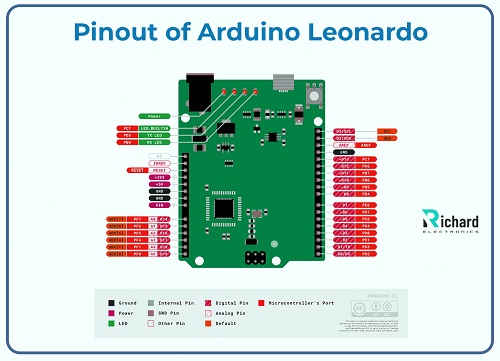The Arduino Leonardo is a highly versatile and powerful microcontroller board that stands out due to its capability to emulate a mouse or keyboard without needing any additional libraries. This board is equipped with 20 digital I/O pins, of which seven support Pulse Width Modulation (PWM) output, and 12 analog input pins. It also provides UART, SPI, and I2C communication support. Let's take a closer look at its history, pinout, datasheet, features, IDE, and simulation.
**History of Arduino Leonardo:**
Introduced in 2012, the Arduino Leonardo was developed to extend the Arduino family of microcontroller boards. Built around the ATmega32U4 microcontroller, it features native USB support, setting it apart from earlier models in the series. Unlike previous versions, the Leonardo does not require a separate USB-to-serial converter chip, making it the first Arduino board with native USB communication. Designed for advanced projects requiring direct interaction with computers via a USB port, the Arduino IDE fully supports the Leonardo, enabling easy programming. Its hallmark feature is USB Human Interface Device (HID) compatibility, which significantly differentiates it from previous models. Due to its versatility and innovative design, the Leonardo is widely used in professional prototyping and educational settings.
**Pinout of Arduino Leonardo:**

**Digital Pins:**
| Number of Pins | Type of Pin | Name of Pins/ Protocol | Detail |
|----------------|-----------------------|------------------------|------------------------------------------------------------------------|
| D0 | Serial or Digital I/O | RX (UART) | Used for serial communication receive signals (UART) |
| D1 | Serial or Digital I/O | TX (UART) | Used for serial communication transmit signals (UART) |
| D2 | Interrupt or Digital I/O | Digital Pin | Used for INT2 (External interrupt) or digital output/input |
| D3 | Interrupt, Digital I/O, or PWM | PWM Pin | Used for INT3 (External interrupt) or PWM output |
| D4 | Digital I/O | Digital Pin | General-purpose input/output |
| D5 | PWM or Digital I/O | PWM Pin | Used for PWM output |
| D6 | PWM or Digital I/O | PWM Pin | Used for PWM output |
| D7 | Digital I/O | Digital Pin | General-purpose input/output |
| D8 | Digital I/O | Digital Pin | General-purpose input/output |
| D9 | PWM or Digital I/O | PWM Pin | Used for PWM output |
| D10 | PWM, Digital I/O, SPI | PWM Pin | Used for PWM output or SPI (SS) |
| D11 | PWM, Digital I/O, SPI | PWM Pin | Used for PWM output or MOSI |
| D12 | SPI or Digital I/O | Digital Pin | Used for all purposes digital pin or MOSI |
| D13 | LED or Digital I/O | LED Pin | Connected to the onboard LED |
**Power Pins:**
| Name of Pins | Protocol/Type of Pin | Detail |
|----------------|----------------------|------------------------------------------------------------------------|
| GND | Ground Pin | Used to complete circuits |
| 5V | Power Supply Output | Regulated 5V power supply |
| RESET | Reset Pin | Used to reset the microcontroller board |
| VIN | Power Supply Input | Accepts input voltage between 7V-12V |
| AREF | Analog Reference | Used for reference voltages |
| 3.3V | Power Supply Output | Regulated 3.3V power supply |
**Specific Pins:**
- **Interrupt Pin:** Used for external interrupts.
- **Pin 13:** Built-in LED.
- **SPI:** Used for SPI communication.
- **I2C Pins:** Data line (SDA) and clock line (SCL).
**Analog Input Pins:**
The Arduino Leonardo has 12 analog input pins, each with 10-bit resolution, allowing for readings between 0V and 5V.
**Datasheet of Arduino Leonardo:**
To learn more about its technical specifications, you can download the datasheet by clicking [here](#).
These comprehensive details highlight the capabilities and features of the Arduino Leonardo, making it an ideal choice for a wide range of applications.
Copper Pyrophosphate,Ferrous Phosphate,High Purity Copper Pyrophosphate,High Purity Ferrous Phosphate
Vietnam Fine Chemical Factory , https://www.finechemvina.com